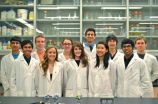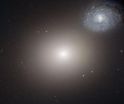(Press-News.org) Tiny strands of RNA affect how our cells burn fat and sugar — a finding that gives biologists a place to start in the quest for therapies to treat obesity and related health problems, said scientists at Virginia Tech and the University of Texas Southwestern Medical Center at Dallas.
Mice on high fat diets are resistant to obesity when two mini-molecules called microRNAS are missing from their genetic makeup, according to a study this week in the Proceedings of the National Academy of Science
The discovery suggests that treatments targeting these two specific microRNAs may help stem the nation's obesity epidemic. More than one-third of adults in the United States and about 17 percent of the nation's children are obese, increasing their risk for type 2 diabetes, heart disease, stroke, liver disease, and some cancers, according to the National Institutes of Health.
"Scientists know the best health solution for obesity involves eating less and exercising more," said Matthew W. Hulver, Ph.D., an associate professor with the Department of Human Nutrition, Foods, and Exercise in the College of Agriculture and Life Sciences at Virginia Tech. "But in cases when people can't or won't exercise, if we can identify what is contributing to the regulation of our metabolic circuits, we can target it with a drug or pharmacologic solution."
Once considered to be little more than scrap DNA, scientists now know microRNAs have an important role in regulating how genes shape human health and behavior. They have been linked to heart disease, diabetes, hepatitis C, leukemia, lymphoma, and breast cancer.
Although microRNAs previously have been linked to obesity, the new findings are the first to establish a connection between microRNAs and cellular metabolism.
MicroRNA biologists at UT Southwestern Medical Center modified mice to be genetically unable to produce microRNA-378 and its cousin miR-378*, resulting in relatively trim animals with metabolisms that quickly convert cellular food into energy.
"We did not know the function of this pair of microRNAs, but were intrigued because they arose from a gene connected with metabolism, and they are expressed in a variety of tissues, such as muscle, fat, and liver," said Eric N. Olson, Ph.D., a professor and the chairman of molecular biology at UT Southwestern and senior author of the study. "When we modified mice so that they were missing these microRNAs, it permitted their cells to burn more energy and have greater obesity resistance than those of their untreated litter mates. This pair of microRNAs seems to function as key regulators of metabolism, suggesting that a drug designed to inhibit them would have a positive effect against obesity."
Olson's lab has examined the results of microRNA changes on various disease states, including heart disease and amyotrophic lateral sclerosis — also known as Lou Gehrig's disease.
In the current study, Virginia Tech scientists, including Madlyn I. Frisard, Ph.D., an assistant professor of Human Nutrition, Foods, and Exercise, and Hulver, director of the Metabolic Phenotyping Core at Virginia Tech, isolated mitochondria — the furnaces within cells that turn fat and other fuel into energy — from liver and skeletal muscle.
When they measured mitochondrial use of fatty acids, they found that a chemical process that releases energy called oxidation was increased, supporting the discovery that loss of the microRNAs results in increased energy expenditure and resistance to obesity, even with a high-fat diet.
"The take home message is microRNAs potentially are a magic bullet against obesity. This is a surprising finding that sheds light on how the body processes food and, in this case, how mice are able to withstand a fat-laden diet and stay skinny," said Gerald W. Dorn II, M.D., the Philip and Sima K. Needleman professor of Medicine at Washington University School of Medicine in St. Louis, who did not participate in the research. "In perspective, people evolved to be able to survive starvation, but as a culture, we're never much farther than a quarter a mile away from McDonald's. It would be nice to tinker with the metabolic gene program, and this research provides a single target that affects how the body deals with energy."
###Hulver is an investigator with the Fralin Life Science Institute at Virginia Tech.
Miragen Therapeutics, a biotechnology company focused on the development of drugs to inhibit specific microRNAs, has licensed the technology from the University of Texas Southwestern Medical Center.
The research was supported by the NIH, the Robert A. Welch Foundation, the American Heart Association, the Jon Holden DeHaan Foundation, the Donald W. Reynolds Center for Clinical Cardiovascular Research and the Leducq Foundation.
Pint-size microRNAs show promise against weighty problem, researchers say
2012-09-06
ELSE PRESS RELEASES FROM THIS DATE:
University of Hawaii cancer researchers discover gene defect responsible for cancer syndrome
2012-09-06
HONOLULU, HI - University of Hawai'i Cancer Center researchers have discovered germline BAP1 mutations are associated with a novel cancer syndrome characterized by malignant mesothelioma, uveal melanoma, cutaneous melanoma and atypical melanocytic tumors. Germline mutations are hereditary gene defects that are present in every cell.
The study investigated two unrelated families with BAP1 defects and found an increase in the occurrence of mole-like melanocytic tumors that are non-cancerous flat or slightly elevated and pigmented skin lesions. These benign skin lesions ...
Students create low-cost biosensor to detect contaminated water in developing nations
2012-09-06
TEMPE, Ariz. – Diarrheal disease is the second leading cause of death in children under five years old — killing as many as 1.5 million children worldwide every year. These startling statistics from the World Health Organization (2009) point to the reason why a group of undergraduate students from Arizona State University is working to develop a low-cost biosensor — a simple device that would detect contaminated drinking water.
An interdisciplinary team of nine students is participating in the 2012 International Genetically Engineered Machine (iGEM) competition — a prestigious ...
Moderate voices muted in political news
2012-09-06
Los Angeles, CA (September 6, 2012) While commentators and scholars argue that political groups have become more polarized in the US, a new study finds that moderate political groups are not as well covered in newspaper articles as more radical right and left-wing groups. This study is found in a recent article from Journalism & Mass Communication Quarterly, a SAGE journal and an official journal of the Association for Education in Journalism and Mass Communication.
"Extremes are more intuitively novel, entertaining, and colorful, representing another common news value," ...
Stem-cell-protecting drug could prevent the harmful side effects of radiation therapy
2012-09-06
Radiation therapy is one of the most widely used cancer treatments, but it often damages normal tissue and can lead to debilitating conditions. A class of drugs known as mammalian target of rapamycin (mTOR) inhibitors can prevent radiation-induced tissue damage in mice by protecting normal stem cells that are crucial for tissue repair, according to a preclinical study published by Cell Press in the September issue of the journal Cell Stem Cell.
"We can exploit the emerging findings for the development of new preventive strategies and more effective treatment options ...
Immune cell death safeguards against autoimmune disease
2012-09-06
Researchers at the Walter and Eliza Hall Institute have discovered that a pair of molecules work together to kill so-called 'self-reactive' immune cells that are programmed to attack the body's own organs. The finding is helping to explain how autoimmune diseases develop.
Dr Daniel Gray and colleagues from the institute's Molecular Genetics of Cancer division and the University of Ballarat discovered that the absence of two related proteins, called Puma and Bim, led to self-reactive immune cells accumulating and attacking many different body organs, causing illness. The ...
A family portrait of galaxies
2012-09-06
6 September 2012: Two very different galaxies feature in this family portrait taken by the NASA/ESA Hubble Space Telescope, together forming a peculiar galaxy pair called Arp 116. The image shows the dramatic differences in size, structure and colour between spiral and elliptical galaxies.
Arp 116 is composed of a giant elliptical galaxy known as Messier 60, and a much smaller spiral galaxy, NGC 4647.
Being a typical elliptical galaxy, Messier 60 on its own may not be very exciting to look at, but together with its adjacent spiral friend, the pair becomes a rather interesting ...
Novel therapeutic targets identified for small cell lung cancer
2012-09-06
PHILADELPHIA — Newly discovered molecular differences between small cell lung cancer and nonsmall cell lung cancer have revealed PARP1 and EZH2 as potential therapeutic targets for patients with small cell lung cancer, according to the results of a study published in Cancer Discovery, a journal of the American Association for Cancer Research.
Currently, small cell lung cancer accounts for about 15 percent of lung cancer diagnoses in the United States. Patients with the disease will initially respond to chemotherapy, but almost all will have disease recurrence within a ...
Master gene affects neurons that govern breathing at birth and in adulthood
2012-09-06
HOUSTON - (Sept. 7, 2012) – When mice are born lacking the master gene Atoh1, none breathe well and all die in the newborn period. Why and how this occurs could provide new answers about sudden infant death syndrome (SIDS), but the solution has remained elusive until now.
Research led by Baylor College of Medicine and the Jan and Dan Duncan Neurological Research Institute at Texas Children's Hospital demonstrates that when the gene is lacking in a special population of neurons called RTN (retrotrapezoid nucleus), roughly half the young mice die at birth. Those who survive ...
Scientists create germ cell-supporting embryonic Sertoli-like cells from skin cells
2012-09-06
CAMBRIDGE, Mass. (September 6, 2012) – Using a stepwise trans-differentiation process, Whitehead Institute researchers have turned skin cells into embryonic Sertoli-like cells.
The main role of mature Sertoli cells is to provide support and nutrition to the developing sperm cells. Furthermore, Sertoli cells have been demonstrated to possess trophic properties, which have been utilized for the protection of non-testicular cellular grafts in transplantations. However, mature Sertoli cells are mitotically inactive, and the primary immature Sertoli cells during prolonged ...
Wild bees: Champions for food security and protecting our biodiversity
2012-09-06
Pollinating insects contribute to agricultural production in 150 (84%) European crops. These crops depend partly or entirely upon insects for their pollination and yield. The value of insect pollinators is estimated to be €22 billion a year in Europe. Declines in managed pollinators, such as honeybees, and wild pollinator such bumblebees, solitary bees and hoverflies, are therefore of growing concern as we need to protect food production and the maintain wildflower diversity.
Scientists involved in STEP, a large-scale project funded by the 7th Framework Program (FP7) ...



